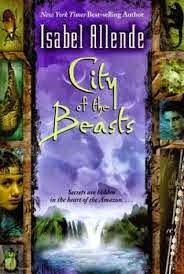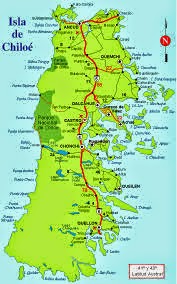Maya's
Notebook
by
Isabel Allende [Fourth Estate paperback, London, 2014]
 |
| Isabel Allende |
Besides
African and Japanese literature, I also like discovering South
American literature. I have just finished reading 'Maya's
Notebook' by the Chilean female writer Isabel Allende.
***
Reading
through 'Maya's Notebook'2
(El Cuaderno de Maya, 2011) has been
another fascinating
experience. Guided by the hand of a Californian teenage girl, this is
a more realistic modern fiction stepping away from a tale-like
narrative. It remains a contemporary adventure in the mood of a real
thriller involving alcoholism, rehabilitation centers,
drug-addiction, the FBI, the mafia and Interpol. The story switches
constantly from the girl's home in Berkeley or the dark sides of Las
Vegas to the island of Chiloé, where she is hiding.
As
Chile is on my bucket's list of countries to visit, I first thought
that Chiloé might simply be a fictive name. Actually, this is an
archipelago in southern Chile having Chiloé3
as its main island. Maya, the main character, often mentions that
potatoes are its main staple food. As a matter of fact most of the
potatoes we eat are indigenous to the island. Manuel Arias, « the
neurotic gentleman » [p.292] she lives with on the island
studies the local
folklore and mythology inherited by the Mapuche4
people.
 |
| Chiloé islands |
In
the second half of 'Maya's Notebook', the plot starts slowly
to unveil. It remains a thriller till the end but there are frequent
interferences with magic, witches and ghosts, making the story even
more fascinating.
There
are also some background descriptions of Chile. « The
cypresses of Chiloé can live for more than three thousand years, and
are among the longest-lived trees in the world, after the baobabs of
Africa and the sequoias of California »[p.23]. The
'Guaitecas cypress5'
was 'once abundant in the region and is now very rare' [sic].
Isabel Allende has omitted to say that the Douglas fir6,
the second-tallest conifer in the world, growing on the northwestern
coast of America from Oregon to Vancouver Island can live from 500 up
to 1,000 years. Maya says that 'the Chilotes' are 'master
boatbuilders who can make anything out of wood. The structures are
created by an ingenious assembly system without using a single nail,
and the vaulted ceilings are upside-down boats' [p.15]. The
capital is also briefly mentioned. « Santiago has six
million inhabitants and keeps growing upward in a delirium of
high-rises under construction. The city is surrounded by hills and
high, snow-capped mountains. It's clean, prosperous, and busy, with
well-maintained parks » [p.324]. Comparing Santiago with Chiloé,
Maya says : « In Santiago I felt stifled
by the
pollution, the trafic, and the impersonal way people treated each
other. In Chiloé, you can tell if someone is an outsider because
they don't say hello in the street ; in Santiago someone who
says anything to strangers is suspicious » [p.325].
Being
a distant cousin to Salvador Allende, Chilean politics are often
hinted in the background, particularly the dark years of the Pinochet
régime, which are entwined in the lives of Manuel Arias and of Nidia
Vidal, Maya's emblematic grandmother she calls her Nini.
« When the military coup happened, on Tuesday, September 11,
1973, the country was divided into two irreconcilable halves ;
no one could remain neutral » [p.326]. She adds that 'that
violence was so unimaginable in Chile, proud of its democratic
institutions and civil society' [p.327].
This
section holds a particular echo for me. A few days after the Chilean
coup, I was on an Italian ship out of Panama, on my way back to
Europe. The ship came from Valparaiso, Chile. On board, there were
many Italian refugees who were escaping Pinochet's military regime.
Allende,
Pinochet and also Michelle Bachelet are mentioned. Talking of
President Michelle Bachelet, Maya says that « no other
Chilean president has been so beloved. […] Before the elections,
nobody thought she'd win, because it was assumed that Chileans would
not vote for a woman, let alone a socialist, agnostic single mother,
but she won the presidency as well as everyone's respect »
[p.318].
The
story ends unexpectedly with a rather humoristic turn, having kept
the avid reader on alert to know what would come next.
***
Isabel
Allende7
was born in 1942 in Lima, Peru as her father, Tomás Allende was a
diplomat at the Chilean Embassy. Her father was President Salvador
Allende's first cousin. In her younger years, Isabel moved to
different countries in Lebanon, in Bolivia or Argentina. She became a
journalist and escaped to Venezuela during the Pinochet's years. In
1988, she met her second husband, a Californian attorney, Willie
Gordon. She still lives in San Rafael, California.
As
a journalist in Chile, she was once asked to make an interview of
Pablo Neruda8(1904-1973),
the world-famous Chilean poet, who won the Nobel Prize for Literature
in 1971. He told her 'she had too much imagination to be a
journalist' and that 'she should be a novelist instead'.
Learning about the death of her 99-year old grandfather, while in
Caracas in 1981, she started her first book 'The House of the
Spirits' (La Casa de los Esperitus, 1982).
She has often been compared to
the Columbian writer Gabriel Garcia Marquez9(1927-2014),
who won the Nobel Prize for Literature in 1982, due to her style
known as 'magical realism'. This term is used to the literary style
that includes magical or unreal elements sometimes mixed with an
otherwise realistic atmosphere.
Christian
Sorand,
Bangkok,
April 2015




No comments:
Post a Comment